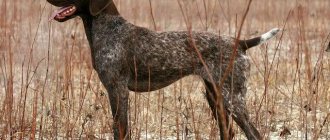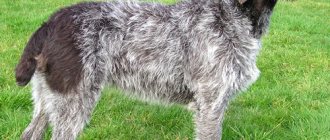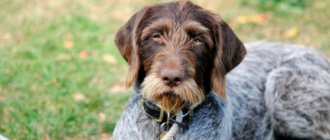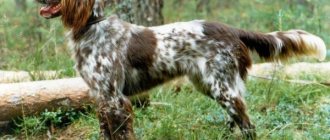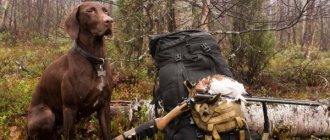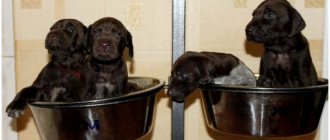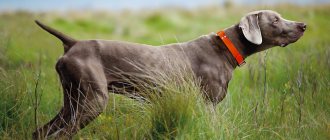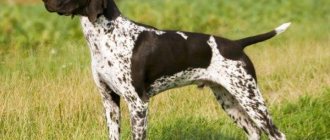Breed traits
Breed traits (on a 5-point scale)
| German Shorthaired Pointer (German Shorthaired Pointer) | |||
| Activity | in the house | 3.5 | |
| on the street | 4.8 | ||
| Obedience | training | 3.7 | |
| strangers | 3.8 | ||
| Domination | in family | 2 | |
| over dogs | 2.9 | ||
| Defending your territory | from people | 2.2 | |
| from dogs | 2.6 | ||
| Sociability | in family | 4.5 | |
| with strangers | 3.5 | ||
| with dogs | 3.7 | ||
| Concentration | in family | 1.5 | |
| in front of strangers | 2 | ||
| with dogs | 1.9 | ||
| Aggressiveness | in family | 1.2 | |
| to strangers | 1.6 | ||
| to the dogs | 2 | ||
| to cats | 2.9 | ||
| Family behavior | calmness | 4.2 | |
| demand for affection | 4 | ||
| excitability | 3.8 | ||
| playfulness | 4.3 | ||
| excessive barking | 2.6 | ||
| behavioral breakdowns | 2.4 | ||
| Tolerance for children | up to 4 years | 4 | |
| over 4 years old | 4.1 | ||
| Institutional use | watchman | 3.6 | |
| bodyguard | 1.9 | ||
This breed is often compared to the following dog breeds: English Pointer, Vizsla Hungarian Shorthair, Weimaraner, Deutsche Drathaar (German Wirehaired Pointer), Labrador Retriever.
The photo shows what a German shorthaired pointer looks like:
German Shorthaired Pointer
Kurzhaar
German Shorthaired Pointer
German shorthaired pointer dog
Shorthaired Pointer breed
Mating
Puberty in female Shorthaired Pointers occurs at approximately 7-8 months, in males - 1-1.5 months later. At this time, strong physiological changes occur in the dog’s body, and behavior changes. Dogs may become more aggressive.
- During the period of estrus, females have noticeable red discharge. The pet will pay a lot of attention to other people's marks and worry in the presence of other females. Having noticed such changes occurring in the dog, you can begin mating.
- It is better to choose a quiet place for mating. If you decide to hold it in an apartment, then you need to arrange a separate room, from which it is better to remove all the furniture. It is better to carry out mating in a freer place - a street, a lawn. The dogs will be able to play first and get to know each other better.
- Before mating, dogs need to be given a good walk. Preferably alone.
- To get puppies, you need to choose the right day for mating. Usually this is 12-13 days after the appearance of discharge. To check if your pet is ready for mating, you need to put your hand on her rump. An indicator of readiness is the tail pulled to the side.
- The knitting itself begins with the so-called “hook”. Cable puts his head on the bitch's withers. So he constrains her movements. And if the female does not resist the cable, she makes a “sit”. First, he pinches her in the lower back with his front paws.
- Then the bitch must move her tail so that the male can get into the loop with his genitals. After several frictions, the genitals begin to swell, which leads to a “lock.” The grip will be strong. The “lock” lasts approximately 5-30 minutes, and ejaculation occurs throughout this time. Therefore, it is better not to touch the dogs at this time.
- At the end of the process, the dogs will separate themselves.
Best articles: Baleen whales: classification, description, nutrition, behavior and threats
Breeders advise doing a control mating every other day.
There are also failures in mating. If there are several attempts, the animals may get tired. Then it is better to separate them into different rooms and let them rest for at least 2-3 hours or even a day.
General characteristics of dogs of the German Shorthaired Pointer breed
The shorthaired pointer breed was developed in Germany. The name comes from the German words kurz, which means “short” and haar, which means “wool”. Related breeds are the Drathaar (wire-haired) and Langhaar (long-haired). And the shorthaired pointer is also called the short-haired pointer.
These dogs were bred to hunt birds and small animals. Just like the drathaar, it is an ideal companion for the hunter. Their unique abilities and character traits have made them popular among ordinary dog breeders.
Owners often call this dog an energizer, a bundle of energy. The shorthaired pointer is truly a very energetic and active dog. She will feel bad in the apartment. Moreover, these pets become strongly attached to their owner and cannot stand loneliness. Therefore, you can only get a shorthaired pointer if you have time to exercise with it, take it out into nature, and run.
This dog needs an experienced owner. She is best in the company of a hunter, athlete or outdoor enthusiast. Shorthaired Pointers find a common language with children, treat them with care and support all games. They get along with other pets, but do not like rodents and birds, since genetically the need to hunt them is inherent in their character.
The German shorthaired pointer is often called the aristocrat among dogs. He has a harmonious, graceful physique, noble posture, and an intelligent, attentive gaze. Elegant appearance attracts attention. High intelligence and obedience make representatives of the breed popular all over the world.
Photos complement the description of the shorthaired pointer breed:
Shorthaired Pointer and game
Shorthaired Pointer on the hunt
Shorthaired Pointer dogs
German Shorthaired Pointer or Shorthaired Pointer
Hunter shorthaired pointer
| Options | Characteristic |
| breed name | Kurzhaar, German Shorthaired Pointer |
| country of origin | Germany |
| time of appearance of the breed | early 19th century |
| group of breeds according to the ICF classification | cops |
| character traits | friendly, inquisitive, active, playful, fearless, balanced, obedient |
| application | hunter, companion |
| life expectancy | 12-14 years old |
| height | males 62-66 cm, females 58-63 cm |
| weight | males 25-32 kg, females 20-27 kg |
| activity | high, requires long walks, active games |
| aggressiveness | not aggressive |
| attitude towards a person | is very attached to the owner, cannot stand loneliness, loves children, |
| intelligence | tall, easy to train |
| health | strong |
| care | easy, although sheds a lot |
| content features | private house with plot |
| who is suitable for | experienced dog breeders, active people, hunters |
pros
Shorthaired Pointers are ideal companions for hunters or outdoor enthusiasts. They look attractive, intelligent and not at all aggressive. These dogs have several other advantages:
- are inquisitive, enjoy learning, quickly understand what is required of them;
- unpretentious, not picky about food;
- hardy, strong;
- calm, balanced;
- obedient and devoted;
- attached to the owner and family members, sociable;
- love children, do not offend them and protect them;
- energetic, playful, cheerful;
- have good health and long life expectancy.
Minuses
The shorthaired pointer is a hunting dog and is not suitable for everyone. If you do not take into account the characteristics of this dog, if you keep and raise it incorrectly, the pet will be sad, become unbalanced, uncontrollable and even aggressive. The disadvantages of shorthaired pointers include:
- poorly suited for keeping in the city;
- need great physical activity and long walks;
- cannot stand loneliness, when they are bored, they can spoil things;
- they shed heavily, short hairs get stuck in furniture upholstery, carpets, and clothes;
- when kept on the site, they like to dig the ground, they can jump over the fence and run away;
- they freeze in cold weather, they need clothes in winter.
Video about the pros and cons of shorthaired pointer:
Video: Shorthaired Pointer Features of the breed. Who is this breed suitable for?
Video: Shorthaired Pointer dog: pros and cons of the breed
Video: Shorthaired Pointer - Interesting facts about the breed
Temperament
The Shorthaired Pointer dog has a balanced, reserved, not nervous, not timid or aggressive character.
The shorthaired pointer has a tendency to dominate, the owner of such a dog must be a strong-willed person, with a strong character, capable of establishing and maintaining his leadership over the shorthaired pointer; if the owner cannot become a leader for his dog, then such a dog can get out of control and become unmanageable.
The shorthaired pointer constantly needs intellectual and physical work, without this the dog will get bored and throw out its unspent energy in the house.
An adult, well-bred shorthaired pointer is a friendly dog that gets along well with children, even small ones. School-age children are the Shorthaired Pointer's best friends in active games.
The shorthaired pointer is strongly attached not only to its owner, but also to all members of his family. The shorthaired pointer must be aware of its own importance, feel needed, loved, and a full-fledged member of a friendly pack. In a critical situation, the shorthaired pointer is able to stand up both for itself and for any other member of its flock.
The shorthaired pointer has good guarding qualities; it is an excellent watchman and protector. A wary attitude towards strangers can lead to aggression, then the shorthaired pointer barks loudly at the stranger until its owner approaches. It is not recommended to develop too strong a protective instinct in a shorthaired pointer, as it can lead to a distortion in the dog’s psyche.
In order for a shorthaired pointer to get along well with other dogs, it must undergo socialization in its youth and learn to have an even attitude towards other dogs.
It is not recommended to keep cats and other pets in the house where the shorthaired pointer lives; after all, the shorthaired pointer is a hunting dog; its strong hunting instinct can turn on at any time, which will lead to dire consequences for other domestic animals.
History of the origin of the German Shorthaired Pointer dog breed
Hunting dogs were very popular in Europe. Researchers believe that the ancestors of shorthaired pointers were brought to Germany from the Mediterranean. Spanish Shorthair Braccos began to be crossed with local hunting breeds. The result was the Württemberg Shorthaired Pointer, popular among German hunters. She is the direct ancestor of the shorthaired pointer.
The breeders sought to obtain an ideal pointer for bird hunting, hardy, fast, and with good scent. For this purpose, pointers, hounds, foxhounds, and Dalmatians participated in the breeding of the shorthaired pointer. Already in the middle of the 19th century, a new breed was introduced. Due to the characteristics of its coat, it was called shorthaired pointer. At the same time, related breeds were bred: Drathaar, Langhaar.
The first standard was created in 1879. But only at the beginning of the 20th century the breed spread throughout the world, captivating dog breeders with its attractive appearance and working qualities. In the 1930s, Shorthaired Pointers came to the United States, where they became known as German Shorthaired Pointers.
During World War II, the dog population was greatly reduced. But already in the 60s of the 20th century, shorthaired pointers became the most popular breed among hunters all over the world. Even now they occupy 16th place in the ranking. Although modern Shorthaired Pointers primarily serve as companions, they sometimes serve in the police and rescue services.
Appearance of dogs of the German Shorthaired Pointer breed
The shorthaired pointer is a large dog. The height at the withers of some males reaches 66 cm, but the physique is elegant and even graceful. Despite the fact that the body is muscular and athletic, the dog looks light. And the weight of a shorthaired pointer rarely exceeds 32 kg, and females weigh 20-27 kg. Therefore, it is classified as a medium rather than large breed.
The standard provides for the following features of the Shorthaired Pointer:
- elegant harmonious physique;
- pronounced muscles;
- short smooth coat;
- long muscular legs;
- dry head with long floppy ears;
- stately posture;
- easy free movements.
The dog's working qualities, balanced temperament, and lack of aggression are most valued. Individuals that do not pass the tests are not allowed for breeding.
Photos complement the description of the appearance:
Head
The head is wedge-shaped, dry, and proportional in size to the body. The skull is wide, rounded, the forehead is convex. The brow ridges are clearly visible, and the stop and occipital protuberance are almost invisible. The muzzle is wide, elongated, gradually tapering towards the nose. It is deep, which makes it easier for the dog to carry game.
The bridge of the nose has a small hump. The lobe is wide, black. But it can be dyed to match the color of the wool. In individuals with a predominance of white color, incomplete pigmentation is possible. The lips are dry, dark, and tightly fitting. A fold is formed at the corners of the mouth. Jaws with a scissor bite, teeth tightly closed, large.
The eyes are medium in size, set slightly askew, brown in color. The look is smart, attentive. The ears are flat, hanging, set high and wide. The size is medium, the tips are rounded, reaching the corners of the mouth. When at rest, the ears are close to the head.
Body type
The physique is harmonious, muscular, the bones are strong, but not heavy. The length of the body is slightly greater than the height at the withers. The neck is long and beautifully curved. The scruff is well defined, there is no dewlap at the throat. The chest is deep, the ribs are arched, the stomach is tucked.
The back is straight and muscular. The loin is short, the croup is wide. The tail is thick at the base and continues the line of the back. Tapers towards the tip, hangs down when calm, reaching the hock joint. It should not rise above the back or bend too much. If the dog is used for hunting, it is recommended to dock the tail at half its length, but in some countries this procedure is prohibited.
Limbs
The limbs are parallel, smooth, muscular. The shoulder blades fit tightly to the body, the elbows are located at the level of the sternum, deep under the body. The joints on the hind limbs are clearly defined. The hips are wide, the legs are long.
The paws are arched, with large claws. The fingers are gathered into a ball, the pads are hard. The movements are sweeping, light, and a proud posture is maintained.
Coat and color
The dog's skin fits tightly and does not form folds. The coat is short - up to 2 cm long, on the head - up to 1 cm. The hairs are hard, reminiscent of bristles, on the head - softer. The coat evenly covers the entire body, lies tightly, smooth and shiny. This is the main difference from its related breed, the Drathaar.
The standard allows several colors. They are usually mottled in color with a black, gray or chocolate tint. The brown shorthaired pointer can be solid, gray, white or gray spotted. With a speckled color, the head is chocolate, large dark spots on the body. Solid brown or piebald colors are acceptable.
The same color options with black. A pure white shorthaired pointer is not recognized as a purebred shorthaired pointer; it must have chocolate or black spots and spots. German breeders prefer darker browns, contrasting colors, as such dogs are more noticeable when hunting.
Photos of shorthaired pointers of different colors:
Disqualifying faults
The standard for this breed has been revised many times; the version from 2001 is currently in effect. He describes in detail what a shorthaired pointer should look like. Any deviations from the standard are unacceptable. Dogs with the following defects and defects in appearance are not allowed for exhibitions and breeding:
- malocclusion;
- short or pointed muzzle;
- incomplete dental formula;
- fleshy lips;
- light eyes;
- short or narrowly set ears;
- pronounced stop;
- wavy coat;
- pendant around the neck;
- hunched back;
- incorrect placement of limbs;
- curving tail;
- ambling or clumsiness in movements.
Possible defects
Like all breeds existing in the world, Shorthaired Pointers have defects. The most common defects are:
- clubfoot;
- absence of incisors;
- short croup;
- too thick or too thin lips;
- visible hunchback;
- short or long ears;
- breasts set too deep;
- completely white color;
- curly hair;
- green or yellow color of the iris;
- light eye pigmentation.
Dogs with the above defects are rejected. Only clinically and functionally healthy dogs, which have characteristics characteristic of this particular breed, can be used for breeding.
Character of the shorthaired pointer
The shorthaired pointer is a unique breed. This is one of the best hunting dogs, superior in working qualities to other pointers, pointers and greyhounds. But at the same time, she is ideal as a companion. He is friendly towards all family members and does not show aggression even towards strangers. This dog will not be able to bite a person, so you should not use it as a guard or watchman. Although in a dangerous situation he boldly rushes to the defense of his owner.
The shorthaired pointer is an ideal dog for families with children. She endures hugs patiently and never snaps. This pet will protect and protect a small child and will play any games with pleasure. But you shouldn’t leave them alone, as the Shorthaired Pointer is quite large and active. For a teenager, this dog will become the best friend.
Kurzhaar is strongly attached to his family, very affectionate and devoted. This dog is ready to accompany its owner everywhere. He is very inquisitive, smart, active. Most of all he loves active games, enjoys running after a bicycle, after a ball, and looking for hidden things. But with the same enthusiasm, this pet will take part in household chores.
Such devotion can create problems: Kurzhaars cannot stand loneliness. They get very bored and may spoil things or howl loudly. If the owner leaves often and for a long time, or does not pay attention to the pet, it can become nervous, disobedient and even aggressive.
This dog is unpretentious and easily adapts to any conditions. Gets along well with other pets, especially if they grew up together. May enter into conflicts with other people's dogs. Small rodents and birds are often perceived as prey. But with proper socialization, the dog will not chase them even on a walk.
German shorthaired pointers can be described in the following words:
- calm;
- obedient;
- friendly;
- sociable;
- devotees;
- cheerful;
- energetic;
- patient;
- sensitive;
- inquisitive;
- hardy.
The photographs show the behavioral features of these dogs:
Training and education of the shorthaired pointer
The shorthaired pointer is one of the smartest breeds; it is intelligent and easy to train. But you shouldn't start training at an early age. It is much more important to socialize the puppy and establish psychological contact with him. First, the pet must learn the rules of behavior and prohibitions that all family members must adhere to. The puppy needs to be accustomed to the toilet, place, he should not be afraid of loud sounds, cars, strangers.
An adult dog must understand basic commands. These are “place”, “to me”, “impossible”, “fu”, “next to”, “sit”, “stand”. When a pet is trained for hunting, it is taught to fetch things, search for objects, and give a voice.
The owner must gain authority from the shorthaired pointer, then the training will be successful. These dogs obey only the leader, but will obey him unquestioningly. They can be stubborn and strive to dominate, especially males. To prevent this from happening, the dog should not climb the stairs or enter the door in front of the person, should be fed after all family members have eaten, should not be allowed to jump on people, or beg for food.
When exercising, these dogs are often distracted by unfamiliar smells, so you need to be patient. Parenting is based on encouragement, affection and trusting relationships. You need to exercise regularly, consistently, gradually increasing the load. Regularly repeat commands learned previously. The following tips will help with training:
- first you need to establish psychological contact and become a leader for the dog;
- carry out training in a place where nothing will distract the pet;
- Physical punishment and rudeness are unacceptable; in case of disobedience, you can scold in a stern voice;
- You need to start training after the dog has run;
- The shorthaired pointer senses the mood of the owner, so you need to carry out the training with pleasure.
Training should be interesting and varied for your pet, otherwise he will quickly get bored. The shorthaired pointer requires not only learning basic commands, but also intellectual pursuits. These dogs love hide and seek, searching for objects, running with obstacles, and swimming. They easily learn various Frisbee tricks and can be taught agility and other sports.
Briefly about hunting with shorthaired pointer
The most popular hunting dog breeds are the shorthaired pointer and the drathaar. These cops are considered the best for hunting birds and small game. They work ideally in unfavorable conditions, climb into any thickets, and are not afraid of water, thorns and insects.
For real professionals, hunting with shorthaired pointer brings pleasure. This dog doesn’t even need special training; working qualities are in her blood. But if it will be used for hunting, it is better to take a special training course. Cops are especially good at hunting birds, hares, and foxes. They cope well with the following responsibilities:
- track game in the field, forest, on the water;
- follow the trail of animals;
- they find wounded game and bring it to the owner;
- take the shot bird out of the water.
Interesting videos about the peculiarities of training and hunting with a German shorthaired pointer:
Video: Shorthaired Pointer training features.
Video: Kurzhaar. Home presentation training.
Video: How to teach a dog to serve game
Key points in training
Any dog should know at least basic commands . Kurzhaar is no exception. If you teach your puppy strict discipline, then it will not be scary to walk with him in the forest or in the city. He definitely won't run away.
Training begins from the day the puppy is brought home. From 2.5 months, the owners accustom him to the following commands:
- Sit;
- Stand;
- Lie;
- Near;
- Aport;
- Voice.
If the owner has no experience in training and is unable to train the puppy, it is better to turn to a specialist.
Read about how to properly train a dog in the article: “Training a puppy: effective methods from dog handlers, learning commands at home.”
Kurzhaar: maintenance and care
The German Shorthaired Pointer is not a lap dog. An adult shorthaired pointer feels best in its own area. There he will have the opportunity to run at any time. For the winter, it is worth equipping your pet with a warm kennel, and during severe frosts it is better to let him inside the house. Due to its short fur, it does not tolerate frost.
When keeping this dog in an apartment or house, you need to walk a lot, at least 4 hours a day. Shorthaired Pointers need active physical activity; they need to run at least 2 km daily. Therefore, it is advisable to walk your pet at a dog park or outside the city, where you can let him off the leash.
At home, you need to provide your pet with a comfortable, spacious bed on the floor away from drafts and heating devices. You should not allow him to sleep on the bed, otherwise the dog may consider himself the leader of the pack.
Hygiene procedures
Caring for the coat of a German pointer is not difficult. It is enough to brush it once a week with a stiff brush. During molting - every day. It is convenient to use a brush or rubber mitt.
Bathing your pet is often not recommended, especially with detergents. This washes away the protective lubricant from the skin. Therefore, you need to wash your paws after a walk, and, if necessary, contaminated areas. The smooth hair on the body can be easily wiped with a damp towel.
Every week you need to examine and clean your pet's eyes and teeth. Dirt often accumulates in the ears, and inflammation can develop. Therefore, they are examined after each walk. To rinse the ears, it is better to use drops or lotion recommended by your veterinarian.
If your dog doesn’t walk on asphalt a lot, you need to trim his nails once a month. And during frequent walks in nature, it is necessary to inspect the paws and face - there may be cuts or wounds from branches and thorns.
Health
Shorthaired Pointers have good health, with proper care they live up to 14-15 years, remaining active until old age. They rarely catch colds and are not prone to gaining excess weight or food allergies. But some individuals have the following hereditary diseases:
- hip dysplasia;
- hypothyroidism;
- diabetes;
- retinal atrophy;
- hemophilia;
- oncological diseases;
- epilepsy.
To protect your pet from infectious diseases, he needs to be provided with proper care. Regularly treat against parasites, carry out timely vaccination. Hygienic procedures will help avoid inflammation of the ears and eyes, and the formation of tartar.
Nutrition
Shorthaired Pointers love to eat and are unpretentious in their diet. Therefore, you can feed them both natural products and industrial feed. The amount of food depends on the activity of the animal. Although cops are not prone to obesity, you should not overfeed them. An adult dog is fed twice a day, a puppy 5-6 times a day.
When feeding natural food, the main part of the diet should be meat and offal. Additionally, you need to give porridge, vegetables, cottage cheese, kefir, eggs. All products must be fresh. You cannot give sweets, fatty, salty and spicy foods, baked goods, legumes, or food from your own table.
Many owners choose dry food. It is more convenient to dose and take with you during trips to nature. The food should be intended for active large breed dogs. Preferably premium or super-premium class. When choosing this feeding option, you should not give your pet natural food.
How to choose a shorthaired pointer puppy
It is better to buy a dog from a specialized nursery, even if you want to buy an ordinary four-legged friend, and not a hunter. Having a pedigree and all the necessary documents is a guarantee that the pet will not have genetic diseases or behavioral defects. If a dog is purchased for hunting, it is also recommended to check the parents' working certificates.
The price of a purebred shorthaired pointer in Moscow is 15-25 thousand rubles. Show class puppies from champion parents will cost more – 30-50 thousand or more. It is not recommended to buy a dog cheaper than 10 thousand; it could be a mixed breed or a sick animal.
Shorthaired Pointer puppies are sold at 2-3 months. At this age, the external signs of the breed are already visible. You need to pay attention to the characteristics of the coat, color, position of the limbs, shape of the muzzle and ears. When choosing a gender, you need to take into account that males are more stubborn, but are better suited for hunting. Bitches are loyal, affectionate, and do not strive to dominate or run away.
The puppy should be active, cheerful, and curious. He should not show cowardice or aggression. A healthy baby has clean eyes and ears, no unpleasant odor, smooth and shiny fur, and a soft tummy.
The photo shows what a shorthaired pointer puppy should look like:
Before getting a dog of this breed, you should watch another video that complements its description:
Video: Kurzhaar - All about the dog breed
Video: Kurzhaar is a real jeep in hunting.
Video: Kurzhaar - Hunter's Dog.
The Shorthaired Pointer dog is more suitable for hunters and athletes. But she can be a wonderful companion. With proper upbringing, this is an incredibly affectionate and sociable dog. He is loving and never shows aggression even towards strangers. This dog strives to please people, is obedient, and easy to train. But it should not be given to homebodies or those who cannot pay attention to it and study properly.
Hunter reviews
Eugene. I have had the Kurzhaar for seven years now. This is an excellent assistant in hunting ducks, partridges and quails. I really like the fact that the dog can do a stance - this makes it much easier to find game. We never returned from hunting without catch.
Anton. I am a hunter, and I can’t even imagine any other dog besides the Kurzhaar next to me. This unique animal is simply created to seek out and pick up game. In addition, our Hans became a real family member for us.
Before you start choosing a puppy, we suggest watching a video about the Shorthaired Pointer breed. We wish you pleasant viewing!
